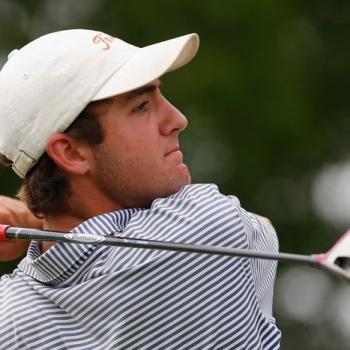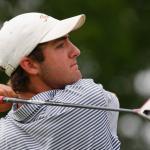I played golf with Lee Trevino the day he said “adios” to the Masters and its hallowed ground—Augusta National Golf Club. He wasn’t ever coming back. For an eligible professional golfer to pass up an invitation to play in the Masters, that’s like a pious pilgrim committing sacrilege by refusing to journey to the world’s greatest shrine or sacred place when the opportunity arises.
For the world of golf during Masters Week, Augusta National is “holy ground.” The golf course is the architectural darling of golf’s only grand slam winner—amateur Bobby Jones, who never turned professional during his illustrious but brief career of winning golf tournaments. On this famed golf course, he worked with eminent golf course designer Alister Mackenzie in sculpturing the magnificent, hilly, brook-filled, tree-lined layout.
Then, in 1934, Bobby Jones started inviting his friends to play there in what he called “the Augusta National Invitation Tournament.” But Bobby’s friend and co-founder of the tournament–Clifford Roberts, who became its director and ruled it a long time with an iron hand–soon got his way and it was renamed “The Masters.” Ever since, all of the best golfers in the world have loved to play in the Masters at Augusta National Golf Club in the springtime. It’s still the first leg of golf’s four major championships.
It was the last round in the 1969 Masters when the Merry Mex said adios to Augusta. Trevino’s career was beginning to blossom like the flowers at the Masters. The previous year, in 1968, he had won his first major championship—the U.S. Open. When Lee and I finished our round that day at Augusta National, he announced to the media that he would never come back to play in the Masters again. He kept his word for awhile. Trevino skipped the Masters in 1970, 1971, and 1974, and then he returned regularly to play through the 1980s. He even led the tournament the first round in 1989 with a 67.
Why wasn’t the talkative, humorous Super Mex going to return to play in the Masters and at least have a sniff of its pretty flowers along the way? (His autobiography, published in 1981, is entitled They Call Me Super Mex.) Lee explained that he couldn’t compete on the Augusta National course. He rightly said you have to hit high iron shots into most of its greens, and on those shots the ball must have lots of backspin. Trevino admitted that he didn’t have that shot in his bag. And he insisted that Augusta National favors long hitters because of no rough and you need a Bobby Jones type draw on half the tee shots. A draw, especially a high hook, wasn’t in Lee’s repertoire. He drove the ball low and straight or with a slight fade. All of us on the PGA Tour knew that Lee Trevino’s bread-and-butter shot was a low fade. He once told me he had a “choke proof swing” that hit his low fade, and I’ve believed him to this day.
When Lee Trevino did return to the Masters, even with major championships to his credit, he never came close to winning the Masters. He won two of each of the other three major championships: the U.S. Open, the British Open, and the PGA Championship, a total of six majors. That’s right up there with the other pro golf legends. But the best Trevino ever did at the Masters was to finish tenth in two tournaments out of a total of twenty Masters in which he played.
Lee Trevino’s announcement to the golf world in 1969—that he’d never play the Masters again because the course didn’t fit his game—was only part of his story. He had another reason for skipping American golf’s treasure. But he never went public with that gripe, and maybe that’s to his creditd as well. He didn’t want to stink up that hallowed ground that helped put golf on the map. Lee was grateful to a game that enabled him to zoom from poverty to riches. What was his other gripe? Lee was upset with the Augusta National Golf Club policy which still had remnants back then of racial discrimination.
In fact, when I started the PGA Tour, in 1964, the tournaments in the Deep South had just started allowing African-American pros like Charlie Sifford to compete in their tournaments. Yet, they wouldn’t allow them to enter the clubhouse. That’s right; they couldn’t even have a locker in the locker room. Lee Elder was the first black pro to play in the Masters.
Why couldn’t Mr. Lee Trevino—the wisecracking, Mexican swashbuckler from Texas who couldn’t speak Spanish—hit any high golf shots? Lee was born and raised in Dallas; but after he did his Marine Corp duty his first golf club job was in El Paso, starting in 1960. So, he said he couldn’t hit high golf shots because of playing so much golf in his windy hometown of El Paso, where even the birds have to walk some days because of strong winds. Lee once told me that he and his friends sometimes used to play golf wearing motorcycle goggles because of sand storms whipping up on a moment’s notice. That El Paso wind made the Super Mex hit the ball so low that I think he could have played the game underground!
Another part of the story about that day at the Masters is that Lee was having one of his worst days on a golf course. Frustrated with his game, he repeatedly was uttering my Lord Jesus’ name in vain. But then, all golfers know that’s nothing new on a golf course. I reckon I’ve heard the words “God” and “Jesus Christ” on a golf course just about as much as I ever hear them in church!
So, I decided that I couldn’t let this opportunity pass. As we walked off the tee on the par-5 fifteenth hole at Augusta National, I came alongside the Super Mex and said, “Lee, I’ve just got to say something to you. You’ve been talking about a good friend of mine all day out here, and I want to tell you about him.” It was the only time in my entire life I’ve ever used that approach with anyone. Maybe Trevino’s response made me cool it.
Well, we had a mutual friend following us in the gallery that day. So, Lee quickly replied, “You talkin’ about Charlie? I haven’t said a word about Charlie all day.”
“No,” I chuckled, “I’m talkin’ about Jesus Christ.” Now, that really got the Super Mex’s attention. And it got us started, or maybe I should say it got Lee started. After that, he never let up on me, always saying something humorous, and maybe sometimes with a touch of sarcasm, about God, Jesus, religion, the church, or all of them combined.
I never heard a pro golfer who could talk more than Lee Trevino–also called the Merry Mex. One time I asked his wife if he ever shuts up when he goes to sleep at night. Sometimes, Lee would talk to the golf gallery right in his own swing while hitting the ball. And I mean during tournament play. The man must have had an amazing power of concentration. I once told him, “Just don’t talk in my backswing. I’m not that good.” Indeed, Jack Nicklaus used to say that, despite Trevino’s braggadocio and swagger, “he doesn’t know how good he really is.”
The following year after our Augusta episode, Lee and I were paired together the first two rounds in the 1970 Houston Open at Champions Golf Club. The greens were in miserable condition that week: very crusty. It seemed that they had more worm casts than grass. Not only that, big, Texas-sized ants were crawling all over those greens. We had just started playing that first round when the Super Mex strolled over alongside me and brashly exclaimed, “Well, Moon Man, I’ve cleaned up my act. No more smokin,’ drinkin’ or cussin’.” I replied, “That’s all very well and good, Lee, but that won’t get you through the pearly gates. You’ve got the cart before the horse.”
I think I had already made myself clear to him back at Augusta what I thought about such things. What all of us sinners need is God’s salvation, and we get it by believing in Jesus Christ dying on the cross for our sins. On that day back at Augusta, Lee had done like so many people do: he turned the conversation around to something else. That time, it was the Catholic Church. He criticized the Church for some things that apparently had stuck in his craw for years. It reminded me of when Jesus confronted the Samaritan woman at the well. She changed the conversation around to asking what was the right place to worship. (Read John 4 in the Bible.) Although I sympathized with Lee’s grievances, I explained that the Church can’t save anybody; only Jesus can.
When we finished that round in the hot, humid weather of heavenly Houston, the media quickly gathered around Mt. Trevino. There never was any better copy on the Tour than the Super Mex’s repartee, unless it was Walter Hagen’s quips a generation earlier. I was standing well within earshot when Lee started in with his typical introduction, “I’m tellin’ ya.” Check out some of his quotations, and you’ll see that those are his favorite words. He uses them just before coming out with one of his pronouncements to get attention. It reminds me of Jesus saying, “Truly, truly, I say unto you,” before he would utter some profound proclamation.
So, the Super Mex blurted out, “I’m tellin’ ya’, it’s tough puttin’ on them bumpy ole’ greens out there.” Then, with a sly grin, and pointing his finger at me, he added, “but it’s double tough playin’ with John the Baptist.” I’ve been called a lot of names in my life, but I regard that as the best one.
One time, I got a somewhat humorous, yet serious, zinger in on the Super Mex. It was 1975. That’s the year the Tour played two back-to-back tournaments in the same city: Chicago. The U.S. Open was played first, at Medinah Country Club, and the next week we only had to travel a few miles to play in the Western Open, at Butler Golf Club. Both tournaments were plagued by rain throughout much of those two weeks.
One day during the U.S. Open at Medinah Country Club, play was suspended temporarily due to lightning. I already had finished my round and arrived back at my motel room. At that moment, play was suspended on the course and players were heading for the clubhouse. I happened to flip on the TV to the local tournament telecast. I may have been the only contestant to have tuned in to that station and seen what transpired next. While Lee was walking off the golf course to escape the downpour, some television announcer accompanied by his roving cameraman, came alongside Lee to interview him while they were walking. The announcer asked Lee if he was worried about the lightning. The Super Mex replied with glee, “The Man upstairs can throw all them firey darts at me he wants to. I’m right with God.”
“Can you believe that?” I shouted out loud. That next week at Butler, here came another one of those big, firey darts. A lightning bolt struck near Bobby Nichols, Jerry Heard, and Lee Trevino who were playing in the same threesome and walking together alongside a lake. It knocked all three of them to the ground. Stunned, they were given first aid. Fortunately, it seemed no one was seriously injured. There was a lot about it in the media that week. And for many years thereafter, there was a lot of speculation about whether that lightning had resulted in permanent injuries for any of those three guys.
A few weeks later I got my chance. I saw Lee on the course and asked him if he really was “right with God” when that lightning bolt hit near him. He knew very well what I was talking about. For once, I witnessed that the Super Mex didn’t have anything to say. It seemed like he wanted to do the same thing as that day in 1969 at Augusta National Golf Club—say “adios” and get the hell out of there!
(Years later, on the Senior Tour, I think I recall correctly that Lee told me he was attending church regularly with his family in Dallas, Texas, where they lived.)














